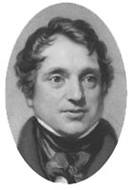|
William Smith may have never become a member of the Geological Society, but his biostratigraphical theories quickly permeated into the development of the science nevertheless. An early example of this influence was the decision in 1813 to begin to rearrange the British specimens in the Society’s Museum, which had previously been classified geographically, into stratigraphical order.
This painting, of the Geological section of the British Association for the Advancement of Science in 1838, shows William Smith on the far right surrounded by Fellows of the Geological Society. The group includes two of the most important stratigraphists of the age - Roderick Murchison (1792-1871) and Adam Sedgwick (1785-1873). Initially working together, these two men identified the Silurian and Cambrian systems through the use of fossils in the 1830s [first paper published in 1835], which led to the establishment of the modern geological timescale.
On 18 February 1831, Adam Sedgwick, as President of the Geological Society, awarded William Smith the first Wollaston Medal which is still the highest honour bestowed by our organisation. In his citation to Smith, Sedgwick described his personal debt to the man he termed ‘The Father of English Geology’:
 “I for one can speak with gratitude of the practical lessons I have received from Mr Smith; it was by tracking his footsteps, with his maps in my hand, through Wiltshire and the neighbouring counties, where he had trodden nearly thirty years before, that I first learnt the subdivisions of our oolitic series, and apprehended the meaning of those arbitrary and somewhat uncouth terms, which we derive from him our master, which have long become engrafted into the conventional language of England’s geologists, and, through their influence, have been, in part, also adopted by naturalists of the Continent.” [‘Proceedings of the Geological Society’, No.20 (1831) p278] “I for one can speak with gratitude of the practical lessons I have received from Mr Smith; it was by tracking his footsteps, with his maps in my hand, through Wiltshire and the neighbouring counties, where he had trodden nearly thirty years before, that I first learnt the subdivisions of our oolitic series, and apprehended the meaning of those arbitrary and somewhat uncouth terms, which we derive from him our master, which have long become engrafted into the conventional language of England’s geologists, and, through their influence, have been, in part, also adopted by naturalists of the Continent.” [‘Proceedings of the Geological Society’, No.20 (1831) p278]
Indeed so keen was the Society to recognise Smith’s achievements that he only received the accompanying purse of 20 guineas and not actually the Wollaston Medal itself which was still being made. Smith finally received the finished Medal at the British Association meeting of 1832.
Included in the painting is also Henry Thomas De la Beche (1796-1855) who became first director of the Geological Survey, the first national organisation founded to systematically survey and map the country’s geology, so as (in an echo of Smithian principles) to be of "great practical utility, bearing on agriculture, mining, road-making, the formation of canals and railroad, and other branches of national industry" [Charles Lyell, Presidential Address, 20 Feb 1836, ‘Proceedings of the Geological Society’, vol 2, No.44 (1836) p358].
When the third edition of the Society’s Geological Map of England & Wales was issued in July 1865, the title was completely revised to read, ‘A Physical and Geological Map of England & Wales by G B Greenough, FRS (on the basis of the original map of Wm Smith 1815) revised and improved under the superintendence of a Committee of the Geological Society of London from the maps of the Geological Survey of Great Britain, 1836-63, and maps and documents contributed by Sir R I Murchison, Professor Phillips, Joseph Prestwich, R Godwin Austen, and others’. However it should be noted that George Bellas Greenough had died in 1855, and Smith’s nephew John Phillips was a member of the committee which oversaw the map’s revision and reissue. Phillips also served two years as President of the Society during this period (between 1858-1860).
In recent times, the Society has further recognized Smith’s achievements by establishing its annual William Smith Meeting and Lecture and an award specifically targeted at practical geologists - the William Smith Medal.
Acknowledgements
The Geological Society Library would like to express its thanks to the following donors whose generosity paid for the conservation and digitisation of the Society's first edition copy of William Smith's 'A Delineation of the Strata of England and Wales...' (1815):
Dr Peter Dolan
Nineteenth Century Geological Maps
Petroc Limited
Dr Dave Williams
Useful links
Strata-smith.com is the largest online collection of Smith maps (including many belonging to the Geological Society) and allows users to view the maps in 3D, compare editions and overlay with modern geological maps. The Geological Society's full William Smith collections can be viewed in our Picture Library.
|